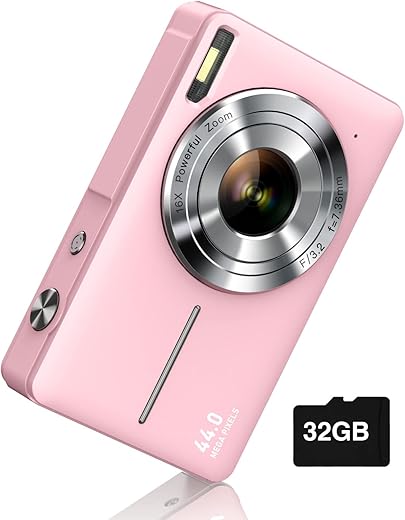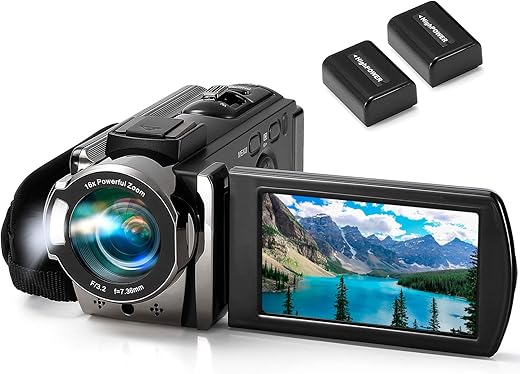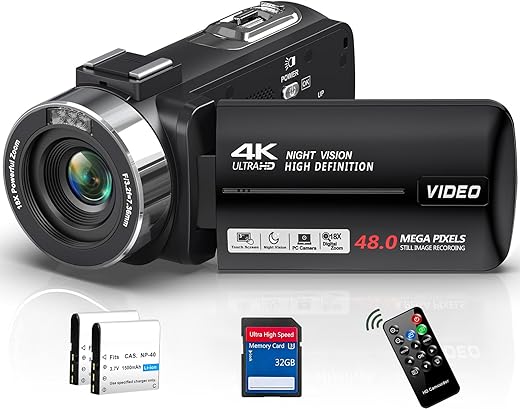In the ever-evolving world of photography, the choice of equipment can significantly influence both the creative process and the final outcome. In this comparative analysis, I will explore the key differences and similarities between a Compact FHD Camera and the Canon EOS R100 Kit. Both options cater to distinct user needs, from portability and ease of use to advanced functionality and image quality. By examining their features, performance, and suitability for various photography scenarios, I aim to provide a clearer understanding of which might best serve different types of photographers.
Effortless Photography
The Digital Camera features FHD 1080P video and 44MP photo capabilities, making it an easy-to-use point-and-shoot option perfect for kids and beginners. With a compact design, long-lasting battery life, and various creative features, it’s an ideal gift for young photographers looking to capture memories effortlessly.
**Vlogging Adventures
The Canon EOS R100 Mirrorless Camera offers exceptional image quality with its 24.1 megapixel APS-C sensor and advanced DIGIC 8 processor, providing 4K video recording and impressive autofocus capabilities. Its compact and lightweight design makes it an ideal choice for those seeking a budget-friendly yet powerful entry into the world of mirrorless photography.
Compact FHD Camera
Image Quality
44MP photos and FHD 1080P video with a CMOS metering system, automatic settings for ease of use.
Portability
Lightweight, compact design suitable for kids, easily fits in a pocket.
Ease of Use
User-friendly interface designed for children, with simple functions and quick setup.
Video Capabilities
Records FHD 1080P video with basic features, suitable for casual use.
Autofocus System
Basic focus features with face and smile detection.
Canon EOS R100 Kit
Image Quality
24.1MP APS-C sensor, 4K video capability, providing superior image clarity and detail with natural bokeh.
Portability
Compact and lightweight design in the EOS R series, optimized for mobility.
Ease of Use
Designed for beginners with an intuitive layout, but offers advanced features for more experienced users.
Video Capabilities
Records 4K video at up to 24 fps, Full HD at 60 fps, and HD at 120 fps, ideal for more serious videography.
Autofocus System
Dual Pixel CMOS AF with 143 zones, advanced face and eye detection, plus animal and vehicle detection for improved focus accuracy.
Compact FHD Camera
Canon EOS R100 Kit
Compact FHD Camera
Canon EOS R100 Kit
Side-by-side comparison


Unique Selling Points (USPs)
Digital Camera (FHD 1080P)
- Compact and user-friendly design tailored for kids and beginners.
- Features 16X optical zoom for versatile candid shots.
- Anti-shake technology for clear images even in motion.
Canon EOS R100
- High-resolution 24.1MP sensor guaranteeing professional image quality.
- Advanced 4K video capabilities perfect for budding filmmakers.
- Interchangeable RF mounts allowing for a variety of lens options.
Pros and Cons
Digital Camera (FHD 1080P)
Pros:
- Lightweight and very portable, ideal for children and travel.
- Affordable option for parents looking for a starter camera.
- Simple usage, optimized for quick snapshots without extensive settings.
Cons:
- Limited image quality compared to DSLRs and mirrorless cameras.
- Lacks advanced features like RAW support or extensive manual controls.
Canon EOS R100
Pros:
- Excellent image clarity and detail with a powerful APS-C sensor.
- Versatile for various photography styles thanks to interchangeable lenses.
- Advanced video recording capabilities for more nuanced storytelling.
Cons:
- Higher learning curve for beginners.
- More expensive upfront cost compared to basic point-and-shoot options.
Conclusion
After thorough comparison, while neither product is definitively superior across all metrics, each has its distinct advantages depending on user needs.
- Digital Camera (FHD 1080P) is the clear choice for casual users, particularly for children or individuals seeking a simple, lightweight device for family gatherings or vacations.
- Canon EOS R100 shines in the realm of serious photography and videography, making it ideal for those who want to invest in long-term photographic pursuits and advanced content creation.
Final Summary
In summary, if you’re looking for an everyday camera that offers convenience and ease of use, the Digital Camera (FHD 1080P) is your best bet. However, if you seek quality, versatility, and the ability to grow your photography skills, the Canon EOS R100 is worth the investment. Your choice should depend on whether you prioritize ease of use or advanced functionality in digital photography.
Top Alternatives to Compact Cameras
Guidelines for Comparing Compact Cameras
When evaluating products within the Compact Camera category, it’s essential to consider a variety of factors that can impact the user experience and functionality of the cameras. Below are general guidelines and key elements to keep in mind while comparing different models, such as a ‘Compact FHD Camera’ versus a ‘Canon EOS R100 Kit’.
Sensor Quality
- Type of Sensor: CMOS sensors are common in compact cameras, offering improved light sensitivity and image quality.
- Megapixels: Higher megapixels can provide more detail, but other factors like sensor size also play a crucial role in image quality.
- Low-Light Performance: Look for cameras with larger sensors and better noise reduction capabilities for better performance in low-light environments.
Lens Specifications
- Aperture Range: A wider aperture allows for better light intake and can produce a shallower depth of field.
- Zoom Capability: Check the zoom range; optical zoom is generally preferable to digital zoom for maintaining image quality.
- Image Stabilization: Having stabilization features helps to avoid blurriness, particularly in low light or while shooting moving subjects.
Video Capabilities
- Resolution: Check if the camera records in Full HD (1080p), 4K, or higher resolutions.
- Frame Rate: Look for options that offer different frame rates (e.g., 30fps vs. 60fps) for more versatility in video production.
- Audio Input Options: Some models have microphone inputs, which can enhance audio quality during video recording.
Size and Weight
- Portability: As compact cameras are designed for convenience, consider the weight and size that suits your carrying preferences.
- Build Quality: Assess the materials used in construction. Metal bodies tend to be more durable than plastic ones.
User Interface and Controls
- Ease of Use: User-friendly interfaces with straightforward menus can enhance your shooting experience, particularly for beginners.
- Manual Controls: Consider whether the camera offers manual controls, allowing for greater creative options in photography.
- Touchscreen vs. Manual Controls: Evaluate if a touchscreen interface or traditional buttons are preferable for your usage.
Battery Life
- Capacity: Look for battery ratings (measured in mAh) and real-world performance based on video and photo usage.
- Recharge Options: Some cameras may provide USB charging, which can be advantageous for travel.
Connectivity Features
- Wi-Fi/Bluetooth: Seamless connectivity options for sharing photos or remote control operation are beneficial.
- GPS: Built-in GPS can be useful for geotagging photos, especially for travelers.
Price and Value
- Budget Considerations: Determine your budgetary constraints and prioritize features important to you.
- Comparative Value: Assess if the price aligns with the features offered; sometimes, spending slightly more can yield significant benefits.
Brand Reputation and Support
- Brand Reliability: Research the brand’s reputation in the camera market for quality and longevity.
- Customer Support: Good after-sales support and warranty options can add peace of mind to the purchase.









I love the compact FHD camera for its portability, perfect for travel!
I kind of feel like the R100 is overkill for casual photography.
Anyone tested low-light performance? How do they compare?
This comparison is super helpful! I’ve been torn between these two options!
The EOS R100 has some great features, but it might be too bulky for my style.
Is the price difference worth it? Looking for a budget-friendly option.
Great article! Can’t wait to see more head-to-head comparisons like this.
Can we talk about the battery life? That’s a dealbreaker for me.
Photos from the Canon are stunning! Really love the color depth.
The compact camera sounds amazing! Who doesn’t love convenience?